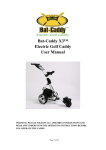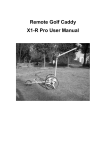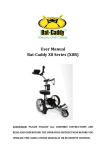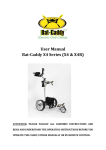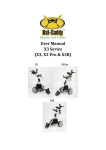Download Bat-caddy X3 PRO User manual
Transcript
User Manual X3 Pro WARNING: PLEASE FOLLOW ALL ASSEMBLY INSTRUCTIONS AND READ AND UNDERSTAND THE OPERATING INSTRUCTIONS BEFORE YOU OPERATE THE CADDY 1. Packing List Standard Parts 1 x Caddy Frame 2 x Rear Wheels 1 x Battery Pack (Battery, Bag, Leads) 1 x Charger 1 x Tool kit Glossary 1 Handle 2 Upper Bag Support 3 Upper Bag Support Strap 4 Battery 5 Rear Wheel (L & R) 6 Wheel Hub Cap 7 Wheel Rubber Tread 8 Battery Tray 9 Lower Bag Support 10 Front Wheel 11 Folding Joint 12 Charger 2. Assembly Instructions 1. Unpack all items carefully and check inventory. 2. FOLD STEP: 3. Attach wheels to axles by pushing wheel locking button on the outside of the wheel and inserting the axle extension into the wheel. Make sure to keep the locking button on the outside of the wheel pushed in during this process, in order to enable the axle extensions, including the two pins, to be inserted all the way into the wheel. If not locked in, the wheel will not be connected to the clutch and will not be propelled!!! Test the lock by trying to pull the wheel out. To disassemble the wheels proceed in reverse order. Attention: Make sure that the right wheel (marked) is attached to the right side and the left wheel (marked) to the left side (seen from behind in driving direction), as the wheels have built in clutches. The caddy will not move if the wheels are not on the proper side. Reverse the action to remove the wheels. 4. Place battery pack on battery tray and fasten Velcro strap around battery and fasten tightly. Insert battery plug into caddy outlet (do not fasten plug screw to prevent damage in case of the battery falling from the tray). 3. Handle Control Display screen Speed Control 1. Timed Distance Advance Function : Press once, display will show A , the caddy will run ca. 10 Meters and stop Press twice, display will show B , the caddy will run ca. 20 Meters and stop Press three times, display will show C , the caddy will run ca. 30 Meters and stop ATTENTION: do not use these functions when the caddy is close to water or other hazards! 2. Cruise Control and Brake Function: 1. ON/OFF Button: controls the caddy’s power supply. Press for ca. 2 seconds in order to switch the caddy ON or OFF (similar to a mobile phone operation) 2. Go/Stop Button. Press once and the caddy will stop, press again trolley will start at the same speed. Timer and Go/Stop button: when trolley goes at 1-7 speed level, start Timer function and press go/stop , this will cancel the Timer function , display will go back to previous speed level, press again and the caddy will go in former speed level. 3. Speed controller Scrolling of the speed button clockwise/forward lets you choose your preferred speed to suit your pace, and the display will show the preferred speed. The speed level goes from 1 to 7. 4. USB plug located under handle cover for GPS or cell phone. Additional Functions Freewheeling Mode; the caddy can be easily operated without power. In order to activate the freewheeling mode, turn main power Off. The caddy now can be pushed manually without resistance. Tracking Adjustment; tracking behavior of all electric caddies is strongly dependent on equal weight distribution and slope. Test your caddy’s tracking behavior by operating it on an even surface without the bag. If changes are necessary, you can adjust the tracking of your caddy by loosening the front wheel axle and the adjustment bar on the right side of the front wheel and shifting the axle accordingly. After adjustment, fasten screws in reverse order. Note: Don’t over tighten the nuts. Installation of Seat Attach seat stand to seat bottom using the four small screws. Attention: Attach in such manner that the seat is parallel to the driving direction of the caddy, with the opening facing the outside when you slide it into the holding bar. Slide seat stand into holding bar as shown. Due to the spring mechanism, the seat should reach the ground when pushed down, so the weight rests solely on the ground. Note: DO NOT attempt to sit on the seat while trying to move the caddy, or frame damage might occur! General Instructions - In order to turn the caddy on push the On/Off switch The LEDs should light up. - While holding on to the handle, start dialing the speed control with your index finger slowly forward, or clockwise. The caddy will start moving forward. Adjust the speed seamlessly to the desired pace. Reduce speed by dialing backwards. - To stop or slow the caddy down, either dial the speed control knob backwards or use the cruise control or On/Off button as described previously. MAINTENANCE & ADDITIONAL INSTRUCTIONS 1. Battery Charging and Maintenance PLEASE OBEY THESE PRECAUTIONS FOR BATTERY USE & CHARGING: - Please do not charge the battery in a sealed container or in upside down position. It is recommended to charge the battery in a well ventilated area. - Please do not charge the battery near a heater, where heat accumulation may occur, or in direct sunshine. - In order to prolong the service life of the battery, please avoid complete discharge and charge the battery after every use. Unplug the battery from the charger once the charge is complete. When the trolley is not in use for an extended period of time, it is recommended to charge the battery once a month. - The battery’s poles’ red color stands for positive, and the black for negative. In case of battery replacement please reconnect the poles of the battery correctly; otherwise your caddy could suffer severe damage. - Please do not disassemble the battery or throw it into a fire; this will cause an EXPLOSION! - NEVER TOUCH THE ELECTRIC POLES OF THE BATTERY! THIS IS A SEVERE SAFETY HAZARD! - READ THE SEPARATELY SUPPLIED BATTERY INSTRUCTION SHEETS Sealed Lead Acid Battery Charging Instructions: Connect the battery cable plug with the charger and then plug the charger into an electrical outlet. During the charging cycle the LED on the charger will show a red steady light. Once the charging cycle is complete the red light, will turn into a steady green light. It is now okay to unplug the charger and battery for reuse. The charging cycle can last up to 12 hours depending on the level of discharge. Normally the battery will hold its charge for several months, and it does not have a “memory effect”, and therefore can be recharged at any discharge level. It is not recommended to fully discharge the batteries, as this will shorten battery life drastically. The battery has a normal lifespan of approx. 150 charges, depending on charging frequency, storage conditions, and time and discharge history, which could reduce this lifetime. Before storing a battery for extended periods of time you must fully charge it. DO NOT store a discharged battery or else it might become unusable. Replacement batteries are available from your authorized dealer or directly from Bat-Caddy. Recommendations - Fully charge the battery for ca. 12 hours before the first use - Do not leave the battery on the charger if it is not used for extended periods of time; remove it from the charger after charge is complete - The battery will take approximately 2-3 rounds and charging cycles before it reaches its full operating potential. During the first couple of rounds it might still be below its optimal power. - Always keep your battery fully charged before another game - Never keep your battery connected to the grid during prolonged power outages. It might be irreversibly damaged. - Do not fully discharge the battery by “overplaying” it. It is recommended to recharge the battery after every 18 holes. 2. Testing Your Caddy Test Environment First, make sure that you perform your first test of the caddy in a wide and safe area, free of obstructions or valuables, such as people, parked automobiles, flowing traffic, furniture or water bodies (rivers, swimming pools etc.), steep hills, cliffs or similar hazards. Manual Control Operation Test the manual function first: Push the On/Off button for about 2-5 second The manual functions of the caddy are controlled through the rheostat control wheel on the top of the handle. Turning the wheel clockwise will control the forward movement of the caddy. In order to slow down or stop the caddy, turn the wheel backwards (counterclockwise). 3. Recommendations for Efficient and Safe Operation - Be alert and act responsibly at all times while operating your caddy, just as you would when operating a riding cart, motor vehicle, or any other type of machinery. We absolutely do not recommend the consumption of alcohol or any other impairing substances while operating our caddies. - Do not operate the caddy carelessly in narrow or dangerous spaces, places with valuables or any people gathering areas, such as parking lots, close to flowing traffic, bag drop-off areas, stores, driving ranges, putting greens and practice areas, pro shops, restaurants, starter areas and other areas where people or items could be harmed through an error or lack of skill in operation. In such situations the caddy should be best operated manually with or without power. Be always close to the caddy to prevent it from getting away. Also, please make sure to always switch off the power and secure the caddy when you park and leave the unit for other than normal play, either on or off course. - With its optimized balance and straight front wheel, the caddy has extraordinarily narrow and responsive turning and maneuvering abilities. However, it sometimes tends to react to uneven weight distribution of its load or slope variations and will follow the weight and the slope of the golf course, which is normal for electric caddies. Therefore, please make sure that the weight in your bag is distributed evenly (move heavy balls and items to both sides equally and to the upper part of your bag, or shift the bag on the caddy). Also, when operating your caddy, anticipate the slope of the course in order to avoid frequent corrections in direction. In some extreme environments, such as very uneven terrain, steep hills, narrow and/or sloped cart paths, muddy areas, gravel paths, close to bunkers and hazard, around bushes and trees it is strongly recommended to operate the caddy by holding on to it to prevent any tip overs, collisions resulting in potential damage. When operating the caddy often in bumpy terrain we recommend to add an additional bungee strap to the lower and/or upper bag support to give the golf bag additional hold and prevent it from shifting. - Please avoid or minimize operation on hard and rough surfaces, such as cart paths, asphalt roads, gravel roads, roots etc., as this will cause unnecessary wear and tear on tires, wheels and other components. Bumping into hard objects might cause damage to wheels or other components. The caddy is best operated on soft and smooth surfaces such as fairways. 4. General Maintenance The steps below will ensure that you get a prolonged and reliable life out of your Bat-Caddy. - The Caddy has been designed so that the user can concentrate on playing golf, while the caddy does the work of carrying your bag. In order to keep your Bat-Caddy looking its best, we advise that you wipe any mud or grass from the frame, wheels and chassis after every round with a damp cloth or paper towel. - NEVER use water hoses or high-pressure jet washers to prevent moisture entering the electronic systems, motors, or gear boxes of the caddy. - Remove the rear wheels every few weeks and clean out any debris that might cause the wheels to drag. You might also consider applying some lubricant, such WD-40, to keep moving parts smooth and corrosion-free. - A 4-5 hour round of golf played once a week for 12 months is equivalent to approximately four years’ use of a lawn mower, so please thoroughly inspect your cart at least once a year, and if you notice any symptoms of wear, contact your Bat-Caddy Service Center. Alternatively, you can have your caddy inspected and tuned by our Service Center, so it’s always in great shape for the new season. - Always disconnect the battery when you store the caddy, and always put your caddy together before re-connecting the battery. If you are not planning to play for at least a month, store the battery in a cool and dry place (not on concrete floor) and don’t leave it on the charger. All of these recommendations and common sense will help keep your Bat-Caddy in top condition and ensure that it remains your reliable partner, both on and off the links. 5. Electronic Systems - Remote Control Range: We recommend not to exceed 50 yards distance. The greater the distance between you and caddy, the greater the chance of losing contact with it (only applicable for remote controlled models) - Microcomputer: The remote caddy has 3 microcomputer controls: The first is in main controller box. The second is in the remote control transmitter handset, and the third is in the receiver in the handle. Non remote caddies have 2 controls (controller box and handle control) - Safety Protection: When the temperature of the controller box reaches its upper limit in case of an overload it will automatically shut down to cool off. - Microprocessor Controlled Electronics System: When you connect the battery, the electronics system will automatically run through a start-up routine. Then you can press the main OFF/ON button on the handle. The power indicator lights will go on, and the caddy is ready for use. - Important: The electronics controller box contains no user serviceable parts. Therefore, it is sealed to reduce the risk of moisture entering and impacting the electronic system. Breaking this seal increases the risk of damaging the electronics and decreasing the reliability of your caddy. DO NOT attempt to open the controller case. Doing so will void the warranty! - Battery Operation and Care: Follow battery charge and maintenance instructions. The battery comes with leads and connector. TROUBLESHOOTING GUIDE Symptom Caddy does not have power Motor is running but wheels don’t turn Caddy pulls to left or right Battery lacks power Problems attaching wheels Action - Check battery cable connections - Check all wiring connections and plugs - Check battery charge - Check On/Off button/switch - Check if wheels are secured to axle by split pin - Check right and left wheel position - Check right/left wheel clutches - Check if wheel is fitted over clutch & latched to axle - Check if axle pin is visible at both sides of axle - Check clutch: turn freely in one direction only - Check cable connections - Check battery charge - Check charger function - Check & Adjust quick release catch












